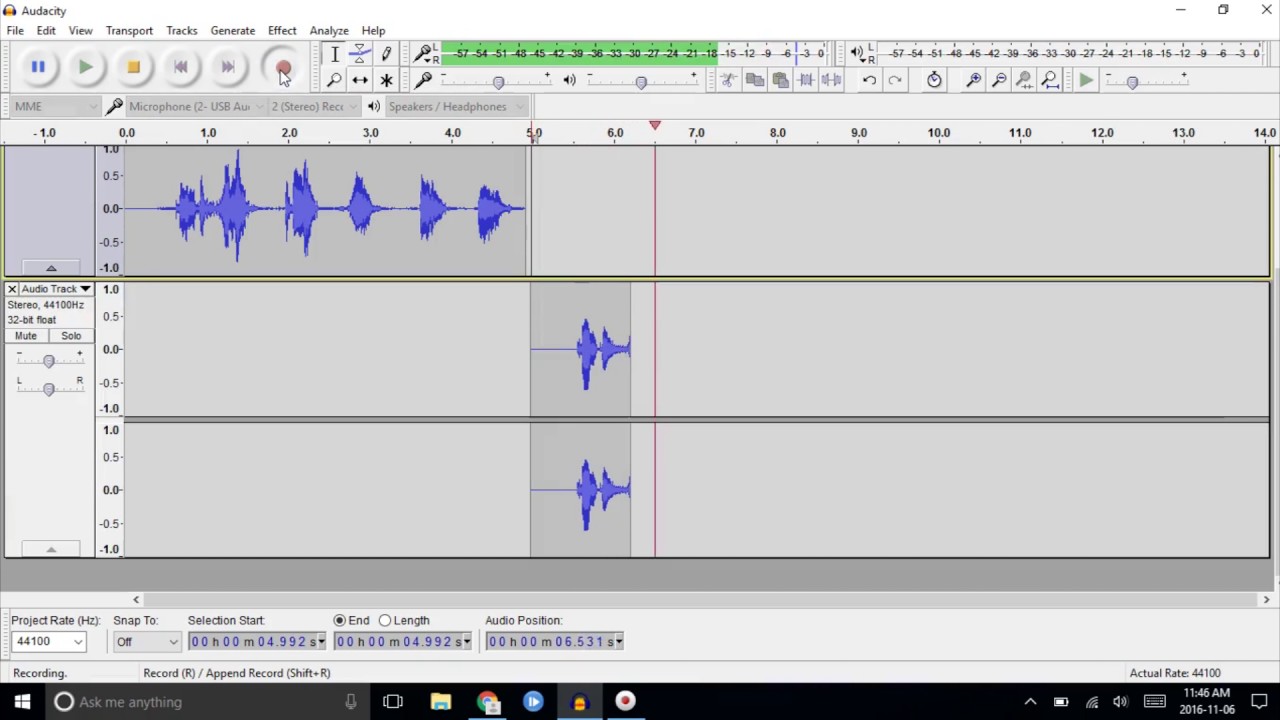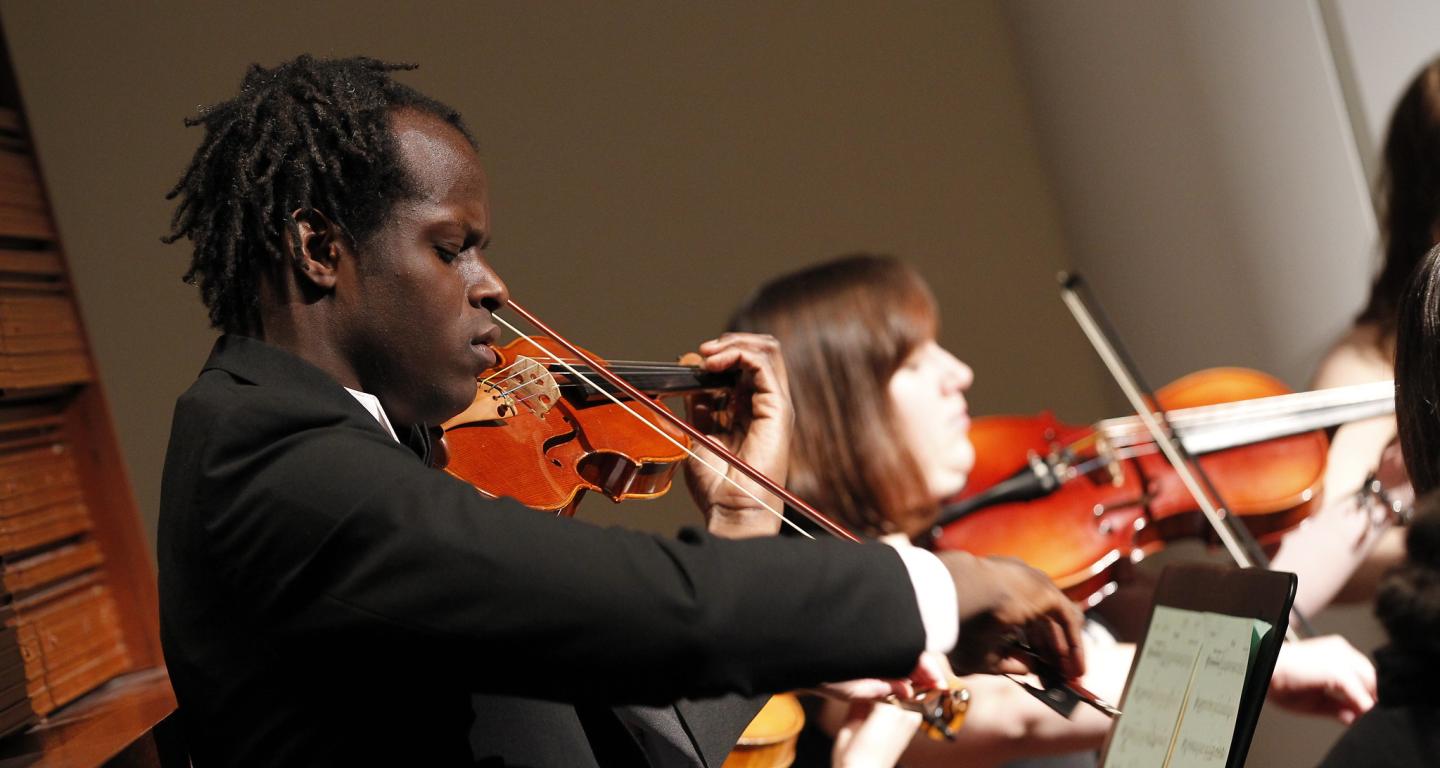Home>Events & Info>Music History>How To Study For A Listening Exam Music History


Music History
How To Study For A Listening Exam Music History
Published: December 28, 2023
Learn how to effectively study for a music history listening exam. Enhance your knowledge of music history and ace your test with these expert tips and strategies.
(Many of the links in this article redirect to a specific reviewed product. Your purchase of these products through affiliate links helps to generate commission for AudioLover.com, at no extra cost. Learn more)
Table of Contents
- Introduction
- Understand the Format of the Listening Exam
- Familiarize Yourself with the Listening Material
- Enhance Active Listening Skills
- Take Effective Notes
- Use Study Guides and Resources
- Practice with Past Listening Exam Questions
- Create a Study Schedule
- Utilize Study Groups or Partners
- Review and Test Yourself Regularly
- Final Thoughts
Introduction
Welcome to the world of music history! As an aspiring music scholar, it is crucial to have a solid understanding of the evolution, genres, composers, and influential musical works that have shaped our cultural landscape. One aspect of studying music history that often poses a challenge for students is the listening exam. These exams typically require students to identify and analyze musical excerpts, demonstrating their knowledge of different styles and compositions.
In this article, we will explore effective strategies for studying and preparing for a music history listening exam. By understanding the format of the exam, familiarizing yourself with the listening material, enhancing your active listening skills, taking effective notes, utilizing study guides and resources, practicing with past exam questions, creating a study schedule, collaborating with study groups or partners, and regularly reviewing and testing yourself, you will be better equipped to excel in your music history listening exams.
It is important to approach your study with enthusiasm and curiosity, as music history is a fascinating subject that is meant to be enjoyed. So, let’s dive in and discover how to ace your music history listening exams!
Understand the Format of the Listening Exam
Before diving into your music history listening exam preparation, it is crucial to understand the format of the exam. Familiarize yourself with the specific requirements and structure of the exam to ensure that you are adequately prepared.
Typically, a music history listening exam consists of a series of musical excerpts played by the examiner or presented in audio format. These excerpts could range from short segments to longer compositions, covering various genres, time periods, and composers.
One important aspect to note is that you may be asked to recognize and analyze the musical elements within the excerpts. This could include identifying the composer, the time period in which the piece was composed, the genre or style, and specific musical elements such as melody, harmony, rhythm, texture, and form. Understanding the terminology and concepts related to these musical elements is essential for success in the listening exam.
Furthermore, pay attention to any additional instructions or requirements specified by your instructor or the exam guidelines. These instructions could include writing short essays on the historical context of a piece or discussing the stylistic characteristics of a particular era.
By familiarizing yourself with the format and requirements of the listening exam, you can tailor your study approach accordingly. Understanding what is expected of you will help you focus on the relevant skills and knowledge needed to excel in the exam.
Now that we have a clear understanding of the format, let’s move on to the next step: familiarizing yourself with the listening material.
Familiarize Yourself with the Listening Material
One of the key aspects of preparing for a music history listening exam is becoming familiar with the listening material. This involves actively engaging with the repertoire, composers, and musical styles that may appear in the exam.
Start by acquiring a comprehensive collection of music history recordings or accessing online platforms that offer a wide range of musical excerpts. Look for recordings that cover different time periods, genres, and composers. For example, listen to pieces from the Baroque, Classical, Romantic, and Contemporary periods. Explore various styles such as opera, symphony, chamber music, and solo instrumental compositions.
As you listen to each piece, make notes on your initial impressions, the musical elements you notice, and any historical context that may contribute to a deeper understanding of the composition. Take note of the featured instruments, unique melodic or harmonic characteristics, and any recurring motifs or themes.
To enhance your familiarity with the listening material, consider researching the composers and their significance within the historical and cultural context. Understanding the lives and influences of composers like Bach, Mozart, Beethoven, Wagner, and Debussy will provide valuable insights into their compositions.
Immerse yourself in the music by attending live concerts, recitals, or opera performances if possible. Hearing the music in a live setting can provide a richer and more immersive experience, allowing you to appreciate the nuances and dynamics that may not be captured in recordings.
Additionally, make use of supplementary materials such as music history textbooks, online articles, and documentaries. These resources can provide valuable insights into the development of musical styles and the historical context in which they emerged.
By familiarizing yourself with a diverse range of listening material and understanding the historical and stylistic elements, you will have a solid foundation for tackling the music history listening exam.
Next, let’s explore strategies to enhance your active listening skills.
Enhance Active Listening Skills
Developing active listening skills is crucial for success in music history listening exams. Active listening goes beyond simply hearing the music; it involves actively engaging with the musical elements, analyzing and interpreting them. Here are some strategies to enhance your active listening skills:
- Focus and eliminate distractions: Find a quiet and comfortable environment where you can fully concentrate on the music. Minimize distractions such as phones or noisy surroundings to create a conducive listening atmosphere.
- Listen multiple times: Play the musical excerpts multiple times to grasp the overall structure and become familiar with the intricacies. Each listening session may reveal new subtleties and details that you may have missed initially.
- Identify musical elements: Train your ears to recognize and differentiate musical elements such as melody, harmony, rhythm, dynamics, and texture. Pay attention to the relationships between these elements and how they contribute to the overall composition.
- Assess mood and emotions: Tune into the mood and emotional expression of the music. Identify the different moods conveyed and consider how the music conveys these emotions through various musical techniques.
- Understand form and structure: Analyze the form and structure of the musical piece. Recognize the different sections, repetition, variation, and development of musical themes. Understanding the form will help you identify key moments and transitions within the composition.
- Make connections: Connect the musical excerpts with their respective composers, time periods, and cultural contexts. Consider the historical significance of the music and its place within the broader musical landscape.
- Practice active listening exercises: Use online resources or guided exercises that specifically focus on improving active listening skills. These exercises may involve identifying musical elements, recognizing composers or specific compositions, or analyzing the style and form of a piece.
By actively engaging with the music and training your ears to recognize and analyze different musical elements, you will develop a higher level of musical literacy. This will not only benefit you in your music history exams but also deepen your appreciation and enjoyment of music as a whole.
Next, we will explore the importance of taking effective notes during your listening sessions.
Take Effective Notes
Taking effective notes while listening to music is an essential skill for studying and preparing for a music history listening exam. It helps you capture important details, analyze musical elements, and create a reference for future review. Here are some tips on how to take effective notes during your listening sessions:
- Use a structured format: Create a note-taking template that includes sections for key elements such as composer, time period, genre, musical elements, and historical context. This will help you organize your notes in a consistent and comprehensive manner.
- Listen actively and pause: As you listen to a musical excerpt, actively listen for specific musical elements or features. Pause the recording when necessary to jot down your observations or insights. This allows you to capture your immediate reactions and thoughts.
- Write concise and clear descriptions: Use concise language to describe the musical elements you hear, such as melodic contour, harmonic progression, rhythmic patterns, or use of instruments. Focus on capturing the most relevant and distinctive aspects of the piece.
- Note historical and contextual information: Make note of any historical or cultural context that is relevant to the piece, such as the composer’s personal life, musical influences, or significant events happening during the time of composition. This will provide valuable context for understanding the music within its historical framework.
- Make connections between pieces: Note any similarities or differences between the piece you are listening to and others you have studied. This will help you recognize patterns, influences, or developments in musical styles across different periods.
- Include timestamp references: If possible, add timestamps to indicate specific moments or sections of the music that showcase particular musical elements or structural features. This will make it easier to revisit and review specific moments in the composition.
- Organize and review your notes regularly: Keep your notes organized and easily accessible. Review them periodically to reinforce your understanding of the material and identify any gaps in your knowledge.
By taking effective notes, you create a valuable resource that can support your study efforts and serve as a reference during your music history listening exam. It helps reinforce your understanding of the music and allows you to articulate your observations and interpretations more effectively.
Next, let’s explore the use of study guides and resources to further enhance your preparation for the listening exam.
Use Study Guides and Resources
When preparing for a music history listening exam, it is beneficial to utilize study guides and resources that can provide additional support and insights. These resources can help deepen your understanding of the repertoire, composers, and musical styles that may appear in the exam. Here are some study guides and resources to consider:
- Textbooks and course materials: Consult your music history textbooks and course materials for comprehensive information on various musical periods, composers, and genres. These resources often provide in-depth analyses, historical context, and recommended listening selections.
- Online platforms and databases: Explore online platforms and databases specifically tailored to music history study. Websites like Grove Music Online, JSTOR, and Oxford Music Online offer a vast collection of scholarly articles, reference materials, and recordings to aid your understanding of specific topics or pieces.
- Music apps and streaming services: Take advantage of music apps and streaming services that curate playlists or specific collections based on different time periods, composers, or genres. These platforms can help you discover new compositions and provide a convenient way to access a wide range of listening material.
- Study guides and practice materials: Look for study guides and practice materials specifically designed for music history exams. These resources often include sample questions, listening exercises, and analysis techniques to help you develop the necessary skills to succeed in the listening exam.
- Online forums and discussion groups: Engage in online forums and discussion groups dedicated to music history. These platforms allow you to connect with fellow students or music enthusiasts, exchange ideas, ask questions, and gain different perspectives on various musical topics.
- Recordings and performances: Explore recordings and performances of the repertoire you are studying. Listening to different interpretations and performances by renowned musicians can deepen your appreciation for the music and provide valuable insights into musical interpretation and expression.
- Library resources: Visit your local library and explore their collection of music history resources. Librarians can assist you in finding relevant books, recordings, and research materials to support your studies.
By using study guides and resources, you can supplement your learning, gain a broader understanding of music history, and expose yourself to various interpretations and perspectives. These resources can provide valuable context, analysis, and listening material to enhance your preparation for the listening exam.
Next, let’s discuss the importance of practicing with past listening exam questions.
Practice with Past Listening Exam Questions
One of the most effective ways to prepare for a music history listening exam is to practice with past exam questions. By familiarizing yourself with the types of questions that may be asked and practicing your listening and analysis skills, you can build confidence and improve your performance. Here are some tips for practicing with past listening exam questions:
- Obtain past exam papers: If possible, try to access past exam papers or practice questions from your instructor, department, or online resources. These exam papers will give you a clear idea of the formatting and difficulty level of the questions.
- Create a simulated exam environment: Set aside dedicated study sessions where you can recreate the exam conditions as closely as possible. This includes listening to the musical excerpts within the given time frame and answering the questions without any external distractions.
- Time yourself: Practice answering the questions within the allocated time limit. This will help you gauge your speed and ensure that you can complete the exam within the given timeframe.
- Listen attentively: Approach each practice question with a focused and attentive mindset. Listen to the musical excerpts multiple times, actively identifying and analyzing the relevant musical elements and the context of the piece.
- Answer as thoroughly as possible: When answering the questions, provide detailed and thoughtful responses. Use specific examples from the musical excerpts to support your answers and demonstrate your understanding of the music and its historical context.
- Review your answers: After completing a practice exam, review your answers and compare them with the model answers or grading criteria. Identify areas where you struggled and areas of strength, and seek to improve your weaknesses through further study and practice.
- Seek feedback if possible: If you have the opportunity, seek feedback from your instructor or classmates on your practice exam answers. Their insights and suggestions can help you refine your listening and analysis skills.
Practicing with past listening exam questions not only helps you become familiar with the format and types of questions but also enhances your ability to listen critically and analyze musical excerpts effectively. Regular practice will sharpen your ears, improve your analytical thinking, and boost your confidence when approaching the actual exam.
Next, let’s discuss the importance of creating a study schedule to effectively manage your music history listening exam preparation.
Create a Study Schedule
To effectively prepare for a music history listening exam, it is essential to create a study schedule that allows for focused and consistent studying. A well-organized study schedule helps you allocate time for different topics, ensures regular revision, and prevents last-minute cramming. Here are some tips to help you create a study schedule:
- Assess your available time: Evaluate your current commitments and obligations to determine how much time you can dedicate to music history study. Consider factors such as work, classes, extracurricular activities, and personal responsibilities.
- Break down the material: Divide the music history content into manageable topics or periods. This will help you create a clear study plan and prevent overwhelming yourself with too much information at once.
- Set specific study goals: Define specific goals for each study session, such as reviewing a specific time period, studying a particular composer, or practicing listening skills. Setting goals helps you stay focused and motivated.
- Establish a study routine: Dedicate consistent time slots for music history study in your schedule. This could be daily or several times a week, depending on your availability. Consistency is key to retaining the information effectively.
- Prioritize difficult topics: Identify the topics or periods that you find most challenging and allocate more study time to them. Prioritizing difficult areas ensures that you have sufficient time to grasp the concepts and strengthen your understanding.
- Mix up study techniques: Use a mix of study techniques to keep your learning engaging and varied. This could include listening to recordings, reading textbooks, taking notes, participating in study groups, or practicing with past exam questions.
- Take breaks: Incorporate short breaks in your study schedule to rest and recharge. Breaks help prevent burnout and allow for better information retention. Use this time to relax, listen to music for pleasure, or engage in other hobbies.
- Track your progress: Keep track of the topics you have covered and your level of understanding. This will help you identify areas where you need to allocate more study time or seek additional support.
- Be flexible: Recognize that unexpected events or changes in your schedule may occur. Be flexible and adjust your study plan accordingly. The key is to maintain a consistent and balanced approach.
By creating a study schedule that works for you, you can effectively manage your time, stay organized, and ensure comprehensive preparation for your music history listening exam. Remember to balance your study efforts with other aspects of your life to maintain a healthy work-life balance.
Next, let’s explore the benefits of studying with others in study groups or with study partners.
Utilize Study Groups or Partners
Studying music history in a group setting or with a study partner can greatly enhance your learning experience and exam preparation. Collaborative studying allows for the exchange of ideas, discussions, and different perspectives, which can deepen your understanding of the material. Here are some benefits of utilizing study groups or partners:
- Sharing knowledge and insights: Studying with others gives you the opportunity to share your knowledge and insights on various topics or pieces of music. It also allows you to learn from your peers’ perspectives and interpretations, which can broaden your understanding.
- Identifying knowledge gaps: Engaging in discussions with study groups or partners can help you identify any knowledge gaps or areas where you may need additional clarification. Explaining concepts to others or hearing their explanations can highlight areas of weakness that you can then address in your study.
- Enhancing listening skills: Participating in group listening sessions or sharing musical excerpts with others can improve your active listening skills. Exploring various interpretations and discussing the musical elements within the excerpts can expand your understanding and appreciation of different styles.
- Testing and reinforcing knowledge: In a study group or with a study partner, you can test each other’s knowledge by asking questions or creating practice quizzes. Teaching and explaining concepts to others can reinforce your own understanding and help identify areas for further study or review.
- Providing motivation and accountability: Studying with others cultivates a sense of motivation and accountability. Knowing that you have committed to a study session with others can help keep you disciplined and focused on your music history preparations.
- Benefiting from different strengths and expertise: In a study group or with a study partner, each individual may bring different strengths and areas of expertise. Collaborating with others allows you to tap into these strengths and learn from each other’s experiences and knowledge.
- Fostering a supportive environment: Studying with like-minded individuals who share a common goal creates a supportive environment. You can provide encouragement, offer guidance, and celebrate each other’s successes throughout the study process.
When forming a study group or finding a study partner, ensure that the individuals are committed, dedicated, and motivated to achieve similar goals. Select a group size that allows for meaningful discussions and equal participation from all members.
By utilizing study groups or partners, you can enhance your learning experience, gain new perspectives, reinforce your knowledge, and ultimately improve your performance in music history listening exams.
Next, let’s discuss the importance of regularly reviewing and testing yourself during your exam preparation.
Review and Test Yourself Regularly
Regular review and self-testing are crucial components of effective exam preparation in music history. By periodically revisiting the material and testing your knowledge, you can reinforce your understanding, identify areas for improvement, and build confidence. Here are some strategies for reviewing and testing yourself during your exam preparation:
- Review your notes: Regularly review your notes from your listening sessions, lectures, and readings. This helps you retain the information and refresh your memory on important details, musical elements, and historical context.
- Summarize key points: Summarize the key points and concepts in your own words. This exercise not only helps you reinforce your understanding but also allows you to practice articulating the information clearly and accurately.
- Create flashcards: Develop flashcards for important composers, musical periods, genres, and key pieces. Include relevant information such as dates, major works, and significant contributions. Use these flashcards to quiz yourself and test your knowledge regularly.
- Quiz yourself with practice questions: Use practice questions and quizzes, including those from past exams or study guides, to assess your comprehension and recall. This helps you become familiar with the types of questions that may be asked and identify areas that require further review.
- Listen to unfamiliar excerpts: Seek out new musical excerpts or compositions that you have not studied extensively. Challenge yourself to identify the musical elements, composer, time period, and style. This exposure to new material expands your musical knowledge and prepares you for potential surprises in the exam.
- Simulate timed practice exams: Set aside specific study sessions to simulate timed practice exams. Use past exam papers or create your own exam-like conditions. This not only tests your knowledge and listening skills but also allows you to become familiar with the time constraints and pacing required during the actual exam.
- Seek feedback: Whenever possible, seek feedback from your instructor, study group, or study partner. Share your answers to practice questions or your interpretations of musical excerpts and discuss any areas of disagreement or confusion. This helps refine your understanding and provides valuable insights for improvement.
- Identify weak areas: Take note of any areas or concepts in which you feel less confident. Dedicate extra study time to these weak areas to strengthen your understanding and mastery.
- Review right before the exam: Set aside time to review key points, listen to important pieces, and refresh your memory on the main composers and musical periods right before the exam. However, avoid excessive cramming, as it can lead to information overload and increased stress.
By reviewing and testing yourself regularly, you reinforce your knowledge, identify areas for improvement, and ultimately build the confidence needed to excel in your music history listening exam.
Now that we have explored various strategies to prepare for the exam, let’s move on to some final thoughts to keep in mind as you approach your music history listening exam.
Final Thoughts
As you approach your music history listening exam, it’s important to keep a few final thoughts in mind to help you succeed and feel confident during the exam:
Stay organized and manage your time: Create a study schedule that allows you to cover all the necessary material, review regularly, and practice effectively. Stay disciplined and prioritize your study sessions.
Engage actively with the music: Develop your active listening skills by focusing on the musical elements, analyzing the compositions, and understanding their historical and contextual significance. Train your ears to recognize and differentiate musical elements to become a confident listener.
Collaborate and communicate: Consider joining study groups or finding study partners to share knowledge, discuss concepts, and test your understanding. Engaging with others can offer new perspectives and foster a supportive learning environment.
Utilize resources and past exams: Take advantage of study guides, textbooks, online platforms, and past exam questions to supplement your learning and practice. These resources provide valuable insights, explanations, and opportunities to test your knowledge.
Take care of yourself: Remember to take breaks, practice self-care, and maintain a healthy work-life balance. Adequate rest, exercise, and relaxation can boost your focus, memory retention, and overall well-being.
Stay confident and trust your preparation: Remember that you have put in the effort and time to study and prepare for the exam. Trust in your knowledge, skills, and ability to analyze and interpret the music. Approach the exam with confidence and a positive mindset.
Review, revise, and perform self-assessments: Regularly review your notes, revise key concepts, and test yourself with practice questions. Use self-assessments to identify areas that need further attention and dedicate additional study time accordingly.
By incorporating these final thoughts into your exam preparation, you will be well-equipped to approach your music history listening exam with confidence and thorough preparation. Remember to stay focused, trust your knowledge, and enjoy the process of exploring and understanding the rich tapestry of musical history.
Good luck!











